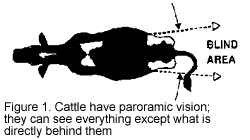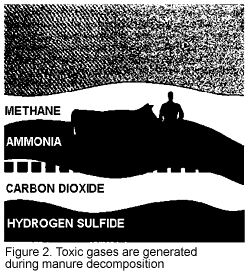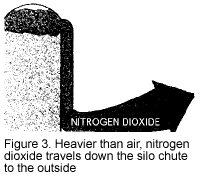Safety Of The Animal Should Be The Only Concern When Handling Animals?
Few farmers view livestock as a source of danger. All the same beast-related accidents cause numerous deaths and serious injuries each twelvemonth. A recent National Safety Council report ranked beef cattle farms second and dairy operations 3rd among all farming enterprises in injuries per hours of piece of work. Seventeen percent of all farm injuries involved animals. This equaled the percentage of injuries acquired by agricultural machinery.
Removing hazards brings you one stride closer to a prophylactic work environment. Whether yous are operating equipment or working with animals, taking a few precautions and observing rubber rules can save you precious time, prevent injury, or fifty-fifty salvage your life.
 Anyone who works with livestock knows each animal has its own personality. Animals sense their surroundings differently than humans. Their vision is in black and white, not in colour. They also accept difficulty judging distances. And differences exist between the vision of cattle, swine and horses. For example, cattle accept close to 360-degree panoramic vision (Effigy 1). A quick movement behind cattle may "spook" them.
Anyone who works with livestock knows each animal has its own personality. Animals sense their surroundings differently than humans. Their vision is in black and white, not in colour. They also accept difficulty judging distances. And differences exist between the vision of cattle, swine and horses. For example, cattle accept close to 360-degree panoramic vision (Effigy 1). A quick movement behind cattle may "spook" them.
Animals have extremely sensitive hearing and can observe sounds that human ears cannot hear. Loud noises frighten animals, and enquiry proves that high-frequency sounds actually hurt their ears. These factors explicate why animals are oftentimes skittish and averse, particularly in unfamiliar surroundings.
Watching animals for signs of aggressiveness or fear alerts you to possible danger. Alert signs may include raised or pinned ears, raised tail or hair on the back, bared teeth, pawing the ground or snorting.
Although handling methods may vary profoundly for different types of livestock, there are some generally accepted rules for working with whatever animal:
- Most animals volition reply to routine; exist calm and deliberate.
- Avoid quick movements or loud noises.
- Be patient; never prod an animal when it has nowhere to go.
- Respect livestock - don't fear it!
- Move slowly and deliberately around livestock; gently bear upon animals rather than shoving or bumping them.
- Ever accept an escape road when working with an animal in close quarters.
Many livestock handling injuries are directly related to equipment or building structures. Poor facilities and equipment can also crusade injuries to animals. This can mean considerable economic loss at market fourth dimension.
Tripping hazards such as high door sills, cluttered alleyways and uneven walking surfaces can cause serious injury and a considerable corporeality of lost piece of work time. Studies accept plant that falls account for eighteen percent of all animal-related accidents.
Concrete floors are all-time for livestock. The finish on physical floors should be roughened to prevent slips under wet weather. High traffic areas, such as alleyways, should exist grooved. Floors should allow water to drain hands. Slatted floors often are used to proceed animals dry out in a confinement system.
Fencing and gates should be strong enough to contain crowded livestock. A variety of materials are available, but the key is strength and immovability. A protruding slice of lumber, a nail or a bolt can crusade painful and infectious injuries. If backed or pushed into, one of these objects can cause a serious back injury.
Alleys and chutes should exist broad enough to allow animals to pass, merely not wide enough to permit them to turn effectually. A width of 30 inches is recommended for a cow-calf operation. For cattle in the range of 800 to 1,200 pounds, a 26-inch width is recommended. Solid wall chutes, instead of fencing, volition lower the number of animals that balk in the chute.
Lighting should be even and diffused. Bright spots and shadows tend to make animals more skittish, particularly virtually crowding or loading areas. Animals move more readily from dark areas into calorie-free, but avoid layouts that make them look straight into the sun.
Handling equipment can speed upwardly livestock confinement work operations, reduce fourth dimension and labor requirements, cutting costs, and decrease the risk of injury.
Hygiene is vital to good livestock direction, specially in confinement systems where diseases can spread quickly. Maintaining a clean, dry surround is apparently important, but other factors as well are crucial.
Ventilation should minimize grit. Various molds that can crusade respiratory also every bit digestive bug may be nowadays in feed. All feeds should be advisedly checked before they are fed to livestock. Deal simply with reliable feed dealers and have suspect feed tested.
All animals, domesticated or wild, can be a source of human disease and parasitic infestation. Diseases that tin can be transmitted between animals and people are referred to as zoonoses.
Rabies Rabies is a deadly virus that affects the fundamental nervous system. It tin can be transmitted by saliva from an infected animal through a seize with teeth, open wound or sore. Although widespread pet inoculation has greatly reduced the threat of rabies, rural people are at greater risk due to their proximity to wild animals. A veterinarian should be called to examine animals observed acting abnormally. Seek immediate medical attention if you are bitten by an animal that you suspect is rabid.
Lyme Illness (LD)Lyme Illness (LD), while only a remote possibility in Missouri, is some other potential threat. Although the tick species known to transmit LD are non nowadays in the country, the organisms that cause LD have been plant in the Lone Star tick, which is constitute in Missouri. Information technology is not known at nowadays whether this tick transmits LD to humans. It may transmit LD to animals, but is known to do so only in its nymphal stage when it is usually constitute on rodents, birds and feral animals such as deer.
If LD occurs, its symptoms may develop within ii to 30 days of the tick bite. A minor red bump appears well-nigh the seize with teeth and enlarges into a spreading red ring. This is followed by a general sickness, including fever, chills, headaches and backache. Some may experience palpitations, dizziness and shortness of jiff.
LD responds well to antibiotics in its early stages, but if left untreated, information technology may accelerate into a chronic stage involving rheumatoid arthritis or cardiac problems.
Brucellosis (Bands Affliction)Brucellosis (Bangs Disease) affects cattle, goats and swine. It can be transmitted to people in unprocessed milk, infected carcasses, or by an aborted fetus or afterbirth from an affected animal. Good sanitation practices reduce the chances that herds will exist infected. Animals should be tested periodically for this affliction.
Trichinosis Trichinosis, acquired by tiny parasites, can exist painful and sometimes fatal to humans. It is transmitted by consumption of uncooked or partially cooked pork. Trichinosis has nearly been eradicated in North America. Thorough cooking is the best prevention.
Salmonella Salmonella organisms are found in poultry and in wild and domestic animals. They can be transmitted to people through contaminated food or h2o. The illness tin can cause severe gastrointestinal distress and fever. Prevention includes proper storage and cooking of animal-derived foods. Good sanitation procedures when handling food reduce the risk of salmonella poisoning.
Other zoonoses also exist. However, preventive measures such as keeping beast facilities clean, testing and immunizing, and using sanitary practices in handling animals and their products minimize the danger.
 Toxic gases, especially in confined spaces such as manure pits, silos and grain bins, can pose hazards to humans and animals (Figure 2). Four gases of major business organization can be found in manure pits. They are hydrogen sulfide (HtwoSouthward), ammonia (NH3), carbon dioxide (COii) and methane (CHfour).
Toxic gases, especially in confined spaces such as manure pits, silos and grain bins, can pose hazards to humans and animals (Figure 2). Four gases of major business organization can be found in manure pits. They are hydrogen sulfide (HtwoSouthward), ammonia (NH3), carbon dioxide (COii) and methane (CHfour).
The principal health hazards of these gases are:
- Toxic or poisonous reactions that can occur in people or animals. Hydrogen sulfide is the most toxic of these gases.
- Oxygen depletion, which tin can consequence in asphyxiation. Hydrogen sulfide, ammonia and carbon dioxide gases are all heavier than air. During agitation of the pit and under conditions of poor ventilation, these gases will replace the oxygen in the air.
- Explosions that can occur when oxygen mixes with the gases. This is primarily a problem with methane.
Characteristics
Hydrogen sulfide:
- Virtually dangerous gas associated with waste material decomposition.
- Distinct rotten egg smell; heavier than air.
- Later breathing this gas a brusque time, sense of smell becomes drawn and y'all may no longer be able to detect any aroma. Gives a false sense of security. At low concentrations the gas irritates the optics and respiratory tract; at moderate levels, causes headaches, nausea and dizziness; at high concentrations, death will occur.
Ammonia:
- Singled-out, sharp, penetrating odor detectable at very depression concentrations.
- Heavier than air.
- At moderate levels of concentration, can irritate optics and respiratory tract; at loftier concentrations, can crusade ulceration to the eyes and severe irritation to the respiratory tract.
Carbon dioxide:
- Odorless, heavier than air, difficult to notice.
- Primarily replaces oxygen in air and acts as an asphyxiant. At moderate concentrations, shortness of jiff and dizziness can occur.
- A major contributing factor to creature deaths by asphyxiation in confinement buildings, which oft occurs during ventilation failure.
Methyl hydride:
- Odorless and lighter than air, so it tends to accrue near the tops of manure pits.
- Considered an asphyxiant at extremely high concentrations. Main risk is its flammable, explosive nature.
Under normal conditions in a well-designed, properly synthetic building with good ventilation, you lot should not have many bug with gas aggregating. Merely serious bug tin can occur if the proper precautions are not followed.
- Provide equally much ventilation as possible in the pit and edifice during agitation of the waste product. Although pits are agitated only a few times a twelvemonth, almost human and livestock deaths or illnesses occur at these times.
- No workers should be nigh the pit or in the building during agitation. If possible, remove all animals from the building.
- Avert entering a manure pit at any fourth dimension, if at all possible. Even if the pit has been emptied, it all the same may exist lacking in oxygen or have high concentrations of toxic gases.
- Always keep at least one human foot of space between the highest manure level and the slats. This protects the animals who lie on the slats and inhale the gases that will accumulate at the surface of the pit.
 Grain, particularly corn, can accumulate loftier amounts of nitrates. During the first 24 to 48 hours of fermentation, significant amounts of nitrogen dioxide (NO2) tin exist released (Figure 3). When this gas is inhaled by silo workers, it can cause a severe chemical pneumonia known as "silo filler'southward disease."
Grain, particularly corn, can accumulate loftier amounts of nitrates. During the first 24 to 48 hours of fermentation, significant amounts of nitrogen dioxide (NO2) tin exist released (Figure 3). When this gas is inhaled by silo workers, it can cause a severe chemical pneumonia known as "silo filler'southward disease."
Nitrogen dioxide is one of the near hazardous lung irritants. It has a pungent, sweetish olfactory property, even in depression concentrations of 5 parts per 1000000 (ppm). It has a ruddy-brown color, visible only when concentrations achieve a unsafe level (75-150 ppm). It is heavier than air and can settle at the lesser of enclosed spaces.
Any concentration over 25 ppm tin be hazardous. The effect on the lungs is oftentimes so subtle that the victim may not realize the serious nature of the exposure until too late. Inhalation of 50 to 75 ppm for 30 to sixty minutes tin can cause bronchitis; l to 100 ppm causes chemic pneumonia; 150 to 200 ppm, a severe fibrosis type of pneumonia; 300 to 400 ppm, severe lung damage, fatal in 2 to 10 days; over 500 ppm, acute pulmonary edema, fatal in less than 48 hours.
- Exercise not allow anyone to enter the silo during the filling process until the blower has run for at least 30 minutes. The pinnacle of the chute doors should be kept as close equally applied with the silage level. This allows heavier-than-air gases to be blown down the chute.
- Do not for whatsoever reason let anyone to enter the silo for 7 to 10 days after the filling process is completed. It is during this time that the fermentation process is occurring and producing the toxic gases.
- Provide skilful ventilation effectually the base of the silo during the fermentation process so that the gases will be carried away.
- Provide fencing to prevent children and animals from straying into any spaces adjoining a silo during this dangerous period.
- When the silo is opened, the blower over again should run for a minimum of 30 minutes before entry. Given a proper fermentation, no further gas product should occur.
- Never enter a silo without someone on the outside monitoring your activity.
For information about grain storage, come across MU publication G01969, Safe Storage and Treatment of Grain.
Dusts are the most common danger in the air when working around livestock. Some types of dust are more dangerous than others. Only all dust tin can crusade serious wellness problems to an individual, depending on the amount, type and length of exposure.
Some dust carries antigens that cause severe irritation to the respiratory tract and lungs. This often results in lung harm. The most mutual course is known every bit "farmer's lung." It results from breathing moldy fodder or grain, usually hay. Farmer'due south lung is one of the most disabling diseases amongst dairy farmers.
Farmer's lung symptoms often are non noticed until several hours after exposure to the dust. Symptoms oft are mistaken for bronchitis or pneumonia. If the affliction is not diagnosed early, irreversible lung impairment and sometimes death tin can result.
Farmer's lung will limit the corporeality of work a farmer can exercise because shortness of breath will crave frequent rest periods.
"Nuisance grit" is the term for other forms of dust that are frequently inhaled while working with livestock. Breathing dusty air of this type for long periods volition crusade areas of your lungs to become hardened and inelastic, and your capacity to take in needed oxygen volition be reduced. Furthermore, your susceptibility to respiratory diseases like pneumonia may increase.
- Store only dry, well-cured forage or grain. Mold develops from the oestrus generated past moist or moisture stored fodder and grain.
- Burn down moldy grain or hay.
- Keep livestock areas as clean equally possible to prevent dust from collecting.
- Vesture a dust mask in dusty piece of work areas to keep harmful dust out of your lungs.
Foot injuries are frequent in all types of livestock facilities. Wear prophylactic shoes or boots. Composition and blazon of sole configuration as well are important to combat the problems of uneven and wet footing.
If you must enter a manure pit or silo without a cocky-contained animate apparatus, plough on all forced ventilation equipment for a minimum of 30 minutes.
Wear a harness or tie a rope around your waist and accept at least i person holding the lifeline. If you are overcome by the gas, this lifeline is your only means of rescue without endangering other people.
A self-independent breathing apparatus is recommended, only its high price may brand it impractical to accept this equipment readily available on near farms.
- Liquid manure holding facilities should be secured against entry. Outdoor lagoons and ponds should be fenced.
- Good housekeeping is essential, non but for your personal rubber, simply also for the health and well being of your stock.
- Keep children abroad from animals, particularly in livestock treatment areas.
- Most male person animals are dangerous. Use special facilities for these animals and exercise extreme caution when handling them.
- Exist calm and deliberate when working with animals. Always go out yourself an "out" when working in shut quarters.
- Respect all animals. They may non purposely hurt yous, only their size and bulk make them potentially dangerous.
- Near animals tend to be aggressive when protecting their young; exist actress careful around newborn animals.
- Stay articulate of animals that are frightened or "spooked." Be actress careful around strange animals.
- Monitor entry into your operation; sales and service personnel could bring diseases from other farms.
- Keep facilities in skillful repair. Chutes, stalls, fences and ramps should be maintained regularly.
Publication #: GO1931
This document is published by Missouri Academy Extension, the Academy of Missouri-Columbia, Columbia, MO 65211. Publication date: October 1993. Partial funding for this guide sail was provided by the University of Missouri-Columbia/National Institute for Occupational Safety and Health Cooperative Agricultural Promotions Agreement.
David Eastward. Baker and Rusty Lee, Section of Agricultural Engineering, University of Missouri-Columbia, Columbia, MO 65211.
Disclaimer and Reproduction Information: Data in NASD does not stand for NIOSH policy. Information included in NASD appears by permission of the author and/or copyright holder. More
Source: https://nasdonline.org/1086/d000876/animal-handling-safety-considerations.html
Posted by: merrymanblene1972.blogspot.com

0 Response to "Safety Of The Animal Should Be The Only Concern When Handling Animals?"
Post a Comment